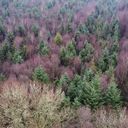













Originally found in North America, the Douglas fir (Pseudotsuga menziesii) is actually not a true fir tree. It was introduced to Europe in the early 19th century by David Douglas, a Scottish botanist and collector who first reported its extraordinary nature and potential. It has also been known as the Oregon pine. The Douglas fir grows quickly, thrives in cold conditions, and can grow to an enormous 100m tall.
After being introduced to France, the Douglas fir has become the second most popular reforestation species. Thanks to its resistance to cold, frost, snow, and wind, EcoTree plants Douglas fir in both France and Denmark, in cold and wet regions for reforestation or continuous cover forestry. The tree is home to a great number of animal, vegetal, and fungal species. Its natural durability renders it rot-proof, an indispensable quality, especially when used as timber.
The Douglas fir is a resilient tree that can grow in all conditions, from the cold of winter to the intense heat of summer. However, when it is very young, it needs plenty of light to prosper and in its early years, it can succumb to winter droughts, violent winds or even a late frost.
Originally, the Douglas fir grew in regions where the climate is mild and humid. In Europe, it is sensitive to the dryness of the air, especially when young. We plant Douglas fir in spring and autumn, making sure that they are positioned in the sun or mid-shade.
This is a tree that will grow in all types of well-drained soil, so long as it is humid, free from chalk and has low acidity.
The wood from a Douglas fir is hardy, perfect for high-quality building materials.
Its heartwood is pinkish brown while its sapwood is light yellow-brown. The grain is very straight with large rings, a testament to the tree's fast growth, and a strong texture mostly on the most recent wood.
Of great size with many twigs, the heartwood of the Douglas fir is more solid and resistant than most conifers usually planted throughout North America and Europe. This helps make the Douglas fir's wood ideal for traditional carpentry.
It is no surprise that Douglas fir represents resilience and durability. Perhaps that makes it the ideal gift for a special wedding day or a long-lasting friendship?
Anyone can give a tree as a gift through EcoTree. Many people choose the Douglas fir because it symbolises a relationship that is built to last.